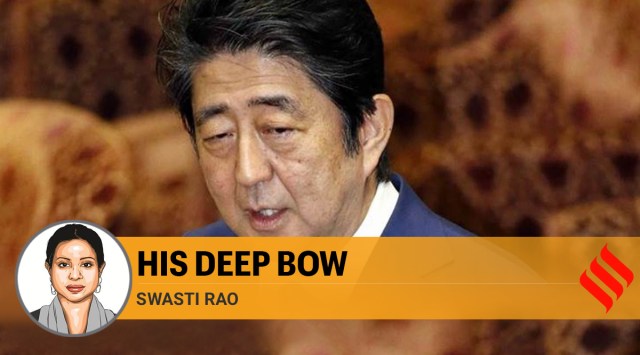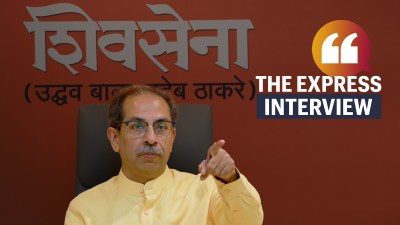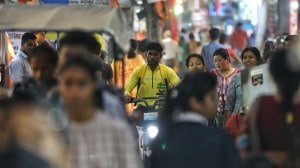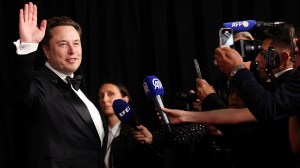- India
- International
Shinzo Abe’s élan, his resolute foreign policy in disturbed international times shall be missed
Despite Shinzo Abe's failings, he represented stability both at home and abroad as he took up resurrecting a liberal order in Asia that US President Donald Trump had abandoned.
 A controversial leader, Abe strove to change Japan’s defence strategy and tried to revise its pacifist constitution and revive Japan’s economy with Abenomics. (AP Photo)
A controversial leader, Abe strove to change Japan’s defence strategy and tried to revise its pacifist constitution and revive Japan’s economy with Abenomics. (AP Photo)Images of a visibly tired Shinzo Abe, the longest-serving Prime Minister of Japan, apologising to the Japanese people with low cast eyes are afloat in international media. His surprising resignation due to deteriorating health has come amidst turbulent times in the Indo-Pacific and the world at large. Despite his failings, he represented stability both at home and abroad as he took up resurrecting a liberal order in Asia that US President Donald Trump had abandoned.
A controversial leader, Abe strove to change Japan’s defence strategy and tried to revise its pacifist constitution and revive Japan’s economy with Abenomics (the nomenclatural inspiration for our Modinomics). He delivered consequential agreements, such as multilateral trade agreements in the Pacific (the CPTPP) and the Atlantic (the Japan-EU Economic Partnership Agreement), as well as the Australia-Japan-US Trilateral Infrastructure Partnership.
India saw great strides in the bilateral relations 2014 onward. Whether it was the Indo-Japanese civil nuclear energy deal or the catchy synergy of Abenomics-Modinomics, India-Japan bilateral relations seemed better than ever. Abe promised a 3.5 trillion yen in investment and planning and India reciprocated in October 2014 with establishing the “Japan Plus” office in the Ministry of Commerce as a “one-stop” location for resolving problems faced by Japanese companies. Upbeat, the two leaders were to sign a key military logistic pact, Acquisition and Cross Servicing Agreement (ACSA), and, in combined efforts to oust a hostile enemy in China, discuss the possibility of some Japanese manufacturing units shifting to India.
So, what went wrong? Who is likely to succeed Abe? What would be the major implications of this apparent power vacuum in post-pandemic times? And finally, what does this hold for India?

The blow to his popularity came from Abenomics that delivered little on the ground. Abe was elected eight years ago primarily due to his economic promises. He will now leave the country in the worst economic crisis in decades. The second quarter of 2020 saw growth shrink by almost 8 per cent. The Nikkei Index has dropped 2.1 per cent at the news of his resignation.
Explained: Why New Delhi will miss Shinzo Abe, who gave new shape to Japan’s India ties
Abenomics was about reviving a stagnant Japanese economy with three “arrows” — a hyper-easy monetary policy, fiscal stimulus and most importantly, structural reforms like corporate reform and labour liberalisation. The structural reforms never happened and faultlines started to appear. Abenomics over-leveraged the economy to the point of sovereign bankruptcy and confidence in capital markets declined. While corporations and hedge fund managers did well, the average person couldn’t see any benefits. A consumption tax was introduced in 2019, which hit the consumption cycle badly and created a downward spiral. As the Japanese economy struggled to revive, the pandemic hit hard.
The ruling Liberal Democratic Party has several factions. According to the Kyodo news agency, a decision on Abe’s successor is likely on Tuesday. The winner would hold the post till September 2021. Shigeru Ishiba, former defence minister and Abe’s arch-rival in the party, is a favourite in Japanese media surveys, though he is less popular within the government. Defence minister Taro Kono, and economic revitalisation minister Yasutoshi Nishimura, who is in charge of coronavirus measures, are also contenders. Chief Cabinet Secretary Yoshihide Suga, Deputy Prime Minister and Finance Minister Taro Aso (who was PM during 2007-08) and LDP policy chief Fumio Kishida are also being discussed for the PM’s office. However, the successor is not expected to deviate significantly from Abe’s current domestic and international policies.
Should India be worried?
India has pinned its hopes on formalising the QUAD for establishing a rules-based order for a free and open Indo-Pacific. Would this cooperation continue without Abe? The answer is yes. Abe’s successor is likely to continue with his policies at least until September 2021.
READ | Shinzo Abe resigns: here’s how his tenure was and what happens next in Japan
If so, what really is going to be amiss? Abe’s charm and élan and his resolute foreign policy in disturbed international times shall be missed. On the ground, little is supposed to change with one caveat — lest China chooses to take advantage and escalate military engagement in the disputed Senkaku Islands.
This article first appeared in the print edition on September 1, 2020 under the title ‘His Deep Bow’. The writer has a PhD in Advanced Comparative Politics and Japanese Studies from the University of Tsukuba, Japan, and currently teaches in the Department of Strategic and Security Studies, AMU
EXPRESS OPINION
More Explained
Apr 20: Latest News
- 01
- 02
- 03
- 04
- 05









































